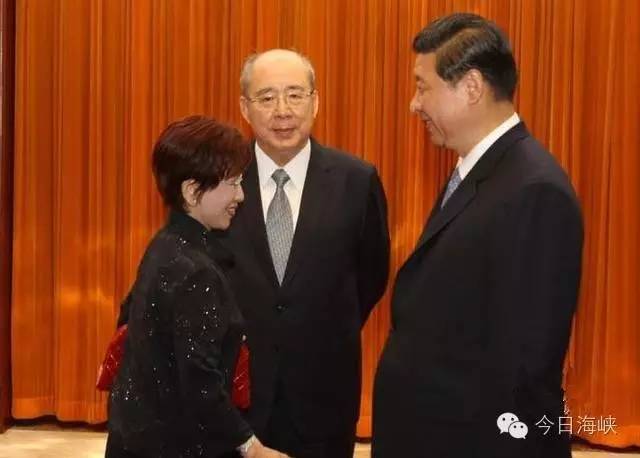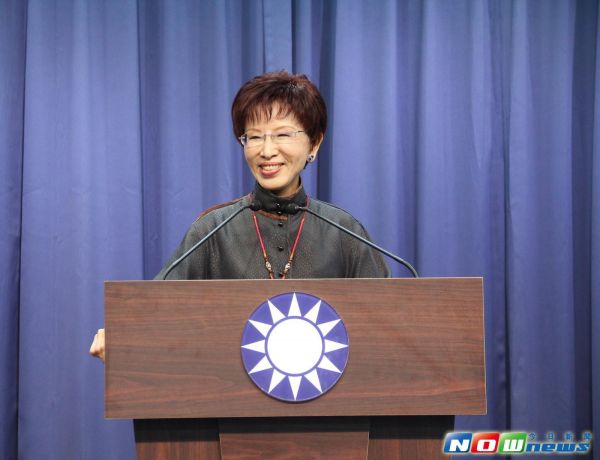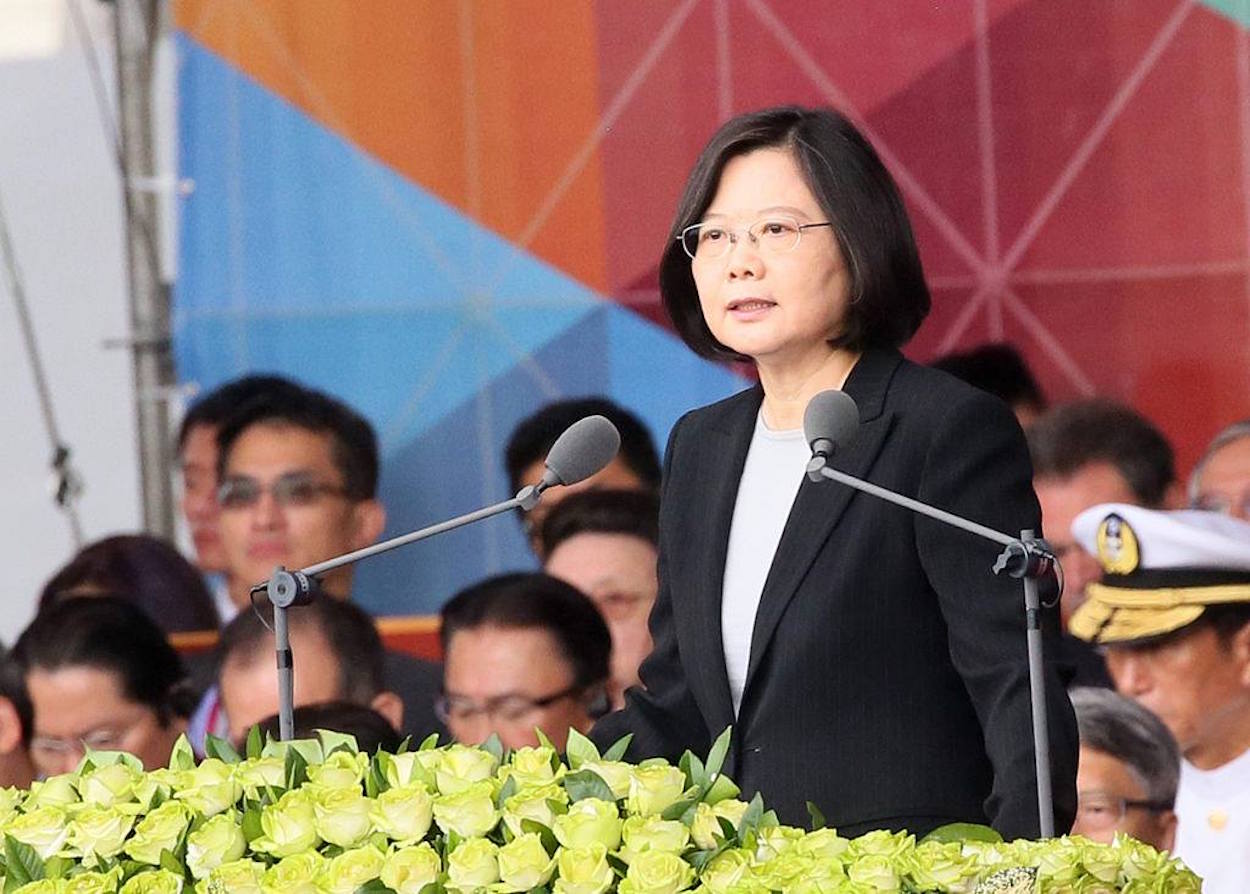by Brian Hioe
語言:
English
Photo Credit: Apple Daily
RECENT NEWS that KMT chairperson Hung Hsiu-Chu will be visiting China next month, with a likely meeting with Chinese president Xi Jinping to take place, is not surprising. Hung has several times in the past suggested that she was hoping to meet Xi, with statements that the KMT does not have faith in the Tsai administration, and that the KMT will not hesitate to take cross-strait relations into its own hands if necessary. Such a meeting would be conducted through the auspices of annual meetings between the KMT and CCP, conducted on a party-to-party basis and claimed to be a product of their special historical relationship. Though the original focus of the forum was economic development between Taiwan and China, given the recent deterioration of ties between Taiwan and China since the Tsai administration took office, the focus of the forum has been changed to “peaceful cross-strait development.”
This would not be the first meeting between Xi and Hung. Hung was part of the Eric Chu’s delegation that went to China to meet with Xi in March 2015, back during Eric Chu’s tenure as chairperson of the KMT and when a meeting between Chu and Xi was conducted on the basis of their positions as chairpersons of the KMT and CCP respectively. Notably, in what was probably a veiled message to Tsai Ing-Wen before her inauguration, when Hung was elected as chairperson of the KMT in late March of this year, Xi immediately sent his congratulations to her.
The CCP Continuing To Pin Its Hopes On The KMT
UNSURPRISINGLY, a Hung-Xi meeting would indicate that China continues to pin its hopes on the KMT to act as its proxy in Taiwan and to combat what it sees as the specter of Taiwanese independence. The KMT aims to leverage on the claim that it is the only political party in Taiwan able to conduct stable cross-strait relations with China and so it should be the party allowed to hold the reins of power, as it has done for many years.
 Previous meeting between Hung (left) and Xi (right) in March 2015, during Eric Chu’s meeting with Xi in Beijing. Photo credit:眾知網/Weibo
Previous meeting between Hung (left) and Xi (right) in March 2015, during Eric Chu’s meeting with Xi in Beijing. Photo credit:眾知網/Weibo
But the CCP continuing to pin its hopes to the KMT occurs despite the current internal crisis of the KMT and the decline of its political fortunes. This is in large part because the KMT is seen as having overstepped its bounds in attempts to draw Taiwan closer to China, as reflected in the 2014 Sunflower Movement and the defeat of the KMT in 2016 presidential elections. China has thus pinned its hopes to the KMT because its views are more amenable to theirs, never mind that this in all probability have the effect of further alienating the KMT from the Taiwanese public and pushing Taiwan further away from China.
While a more intelligent strategy for the CCP might be attempting to split reformist elements of the KMT from its current leadership under Hung or attempting to co-opt increasingly conservative elements of the DPP, the CCP seems committed to “United Front” cooperation with the KMT despite its current direction. Namely, the extreme pro-unification deep Blue elements of the KMT are currently in power under Hung.
We might note that the current wave of backlash against the KMT was not caused by the deep Blue elements of the KMT but by the more centrist party establishment. But rather than pursue reform and localization, as the situation seemed to demand, with the election of Hung to chair of the KMT that represented the party had chosen to try and return to traditional values. This occurs in spite of that massive backlash against the KMT in recent years indicates that the Taiwanese had rejected such values. As such, the KMT under Hung has taken a hard line and expelled rather than embraced potential reformers.
Hung Hsiu-Chu: The Extremist Pro-Unification Leader of the KMT
HUNG IS RIGHTLY thought of as a political extremist by the Taiwanese public. Past statements by Hung can be interpreted as advocating immediate unification with China, a view that even many of those who advocate maintaining the “status quo” find uncomfortable. Hung has at other points demonstrated a nostalgia for not only past authoritarianism in Taiwan under the KMT party-state but a rather rosy view of the CCP’s actions in China.
 Photo credit: NowNews
Photo credit: NowNews
Hung unexpectedly rose from obscurity to become presidential candidate of the KMT due to the power vacuum in the party after massive public backlash against the party following the political crisis precipitated by the Sunflower Movement in 2014. But due to numerous public gaffes revealing of her fringe views during her presidential run, Hung was so unpopular as a candidate that the KMT replaced her mid-race with Eric Chu, despite the fact that Chu also did not stand a realistic chance of winning the presidency. Some speculate that this was because although Chu did not stand a realistic chance of winning either, the KMT party establishment feared that letting Hung’s candidacy run on would be too damaging to the KMT’s reputation for future runs. But, rather than fade back into obscurity, Hung would again unexpectedly rise to party chairmanship in the power vacuum left in aftermath of the KMT’s defeat during 2016 elections.
Hung’s tenure as chair of the KMT has only further accentuated the political crisis of the KMT. But with rumblings of potential attempts to unseat her by party heavyweights in the near future, one suspects that Hung’s meeting with Xi will have the secondary effect of boosting Hung’s standing within the KMT when it comes to struggles over the party leadership. After all, China may genuinely prefer Hung to other contenders for chair of the KMT. Unlike more crafty KMT politicians who know when to draw the line with the Taiwanese public, she quite directly expresses the pro-unification aspirations which China likes to hear. Hung having the favor of China may boost her standing within the KMT for some within the party, even if this will only further marginalize the KMT with the Taiwanese public.
Hung and the KMT’s Attempt to Outflank Tsai and the DPP: Will The Tsai Administration React Badly To A Hung-Xi Meeting?
IF HUNG MANAGES a meeting with Xi, Hung will attempt to depict this as her outflanking Tsai Ing-Wen—that while cross-strait ties have deteriorated under Tsai due to the failures of Tsai’s cross-straits policy, Hung has accomplished a meeting with Xi nonetheless. Given the obvious fact that Tsai outranks Hung as the president of Taiwan, Hung will also try to paint Tsai as ineffectual, with the suggestion that by meeting with the Xi, Hung has accomplished something that Tsai was not able to despite Tsai’s higher position and greater influence.
Of course, one generally suspects that this will only backfire against Hung and the KMT. But it is important to note that Tsai Ing-Wen has stated on the public record that she, too, hopes to meet with Xi on the basis of their positions as presidents of the PRC and ROC. Tsai made this statement during the Ma-Xi meeting in November 2015 between Ma Ying-Jeou and Xi Jinping in their roles as presidents of the ROC and PRC. At that point in time, Tsai did not offer as strong a response to the Ma-Xi meeting as she could have, likely so that if she did angle for a future meeting with Xi after winning the presidency, her past statements could not be used against her. Tsai in fact stated that she would be willing to go Beijing for such a meeting, even though the Ma-Xi meeting took place on the supposedly neutral grounds of Singapore to maintain the semblance of equality between Ma and Xi.
 Tsai during her National Day address. Photo credit: Presidential Residence
Tsai during her National Day address. Photo credit: Presidential Residence
Likewise, while Tsai did not acquiesce to China in acknowledging the 1992 Consensus during her recent National Day address, as some speculated or hoped she would do, her speech did contain an appeal to China to reopen communications. Official communications between Taiwan and China were suspended after it became clear that despite the use of some circuitous words during her inauguration speech, she did not acknowledge the 1992 Consensus or the “One China Principle”. During her National Day address, Tsai also called on China to respect the existence of the ROC.
In recent times the Tsai administration has resorted to bringing in pan-Blue, even deep Blue political actors, for positions in which communications with China are necessary. This includes floating the possibility of Wang Jinpyng, leader of the “Taiwanese” faction, of the KMT, for the position of head of the Straits Exchange Foundation. This would not have been so surprising, seeing as the “Taiwanese” faction of the KMT is not actually so politically remote from some elements of the DPP.
But with the appointment of James Soong as Taiwan’s APEC representative, the Tsai administration has brought on deep Blue politician who was directly responsible for some of the past crimes of the KMT during the authoritarian period. Soong was once been head of the Government Information Office during the period of the KMT’s one party rule and in that role was responsible for information censorship and persecuting dissidents. While the Tsai administration may be hoping to present an image of bipartisanship or to try a wedge between conflicting factions of the pan-Blue camp, the Tsai administration may in fact believe to some degree the KMT and pan-Blue camp’s claims that it is the only political force in Taiwan able to successfully conduct relations with China.
In all probability, a Hung-Xi meeting will only cause blowback against the KMT and CCP from the Taiwanese public. One hopes the Tsai administration realizes this. But surely, if Tsai hopes to meet with Xi in the hopes that this will normalize relations between the ROC and PRC and Hung manages to accomplish this before Tsai through her position as KMT chairperson, Tsai will not be foolish enough to try and ask Hung Hsiu-Chu for favors?
After all, in recent times, Tsai and her administration has been surprisingly tone deaf in taking actions which alienate her support base, in some cases flip-flopping on key platforms on which the Tsai administration was elected. This even included mulling whether to pass the CSSTA trade bill which caused so much backlash against the KMT in the form of the 2014 Sunflower Movement, a key event behind the momentum which led to Tsai’s election. But if most media outlets failed to pick up on this fact, it was a publicly stated position of the Tsai administration that it will seeks admission for Taiwan to not only the US-led TPP, but the China-led RCEP trade agreement. And this goal may open the path for the Tsai administration to try and compromise with political forces with which it should not try to compromise, whose political aims are inherently against the interests of the Taiwanese people.

